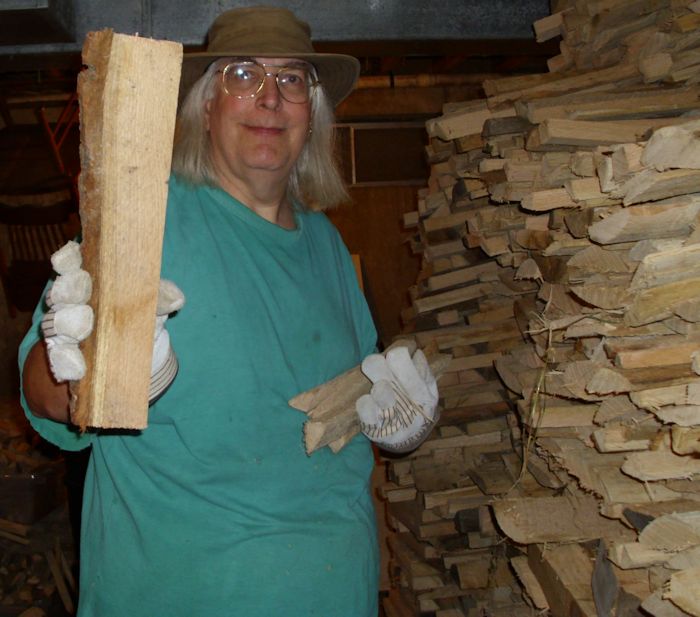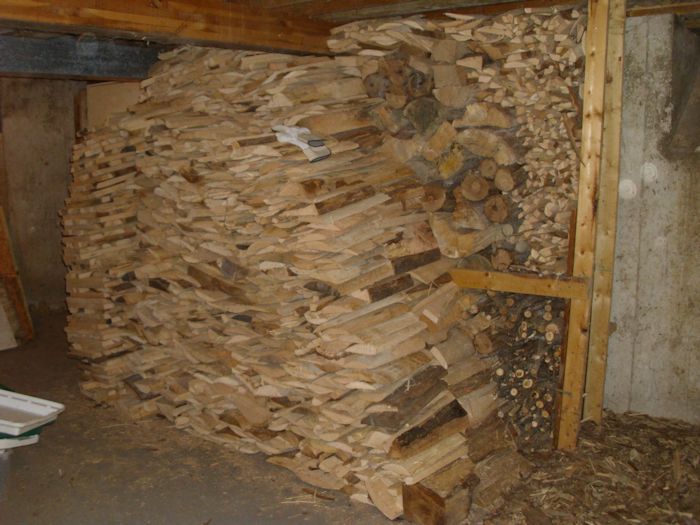Most people are used to viewing firewood as simply cut up logs. The logs are then stacked in cords (128 cu. ft) and proudly displayed outside the home. They have the old homestead or wild west view of wood, with the healthy young male whacking away with an axe and turning perfectly good chunks into kindling. However, real firewood comes in a variety of forms, not just logs. In addition, the wood is often stored in a basement or other area inside the home for easy access and to keep it dry. We actually have firewood in three forms:
- Logs: The old time view of wood cut across the natural growth of the tree. However, unlike the television view of logs, our logs are generally 24″ long and up to 10″ in diameter. No one really takes a huge log and splits it down into kindling (unless absolutely necessary)—they use the copious branches of the tree for that purpose.
- Disks: A wood stove doesn’t care how the wood is oriented. If you put a piece of wood into the stove, it will eventually burn (assuming the wood is dry). In Splitting the Dreaded Elm I discuss how to avoid splitting elm by cutting the tree into disks that will fit into the wood stove sideways. This means we can burn a tree up to 24″ in diameter without splitting it. Most trees that someone looking for firewood encounters aren’t that size.
- Slabs: This kind of firewood is actually the focus of this post. Slab wood is what remains when you turn nicer hardwood logs into boards for furniture or other uses. The slabs are bundled together and you cut them to length with a commercial table saw or a chainsaw.
Slab wood is the sort of firewood that you won’t find at your local store and you generally can’t get it delivered by someone who sells firewood. You actually need to know someone who has a sawmill and is willing to sell you the remnants as firewood. What you receive doesn’t really look much like firewood at all. It doesn’t look like a board either—it looks like wood scrap, which is what it is.
The advantages of slab wood are many:
- It costs a lot less than a cord of logs (usually about half).
- It’s guaranteed dry.
- The presence of flat surfaces makes it easy to stack.
- You know you’re getting quality hardwood that won’t clog your chimney.
- It’s unlikely that the wood will contain any serious pests such as carpenter ants.
Slab wood also has some serious deficiencies:
- It isn’t readily available from most sources.
- You normally can’t buy just one cord.
- There is the problem of cutting the slabs to length.
- It’s absolutely essential that the wood not get wet because it soaks up water like a sponge.
- You must mix slab wood with other kinds of wood because it tends to burn both hot and quickly.
Our wood pile currently contains all three kinds of wood we use. The pile in the basement of our home has mostly logs and slab wood. The outside pile contains logs and disks. Most of the outside wood currently contains pests, such as carpenter ants. After a good freeze, the ants will be gone and we’ll be able to bring the wood inside a little at a time to burn. In the meantime, we have a wonderful assortment of wood inside to use during the cool autumn months.
So, how do you like your wood (slabs, disks, or logs)? What kinds of wood do you prefer to burn? Let me know at [email protected].


